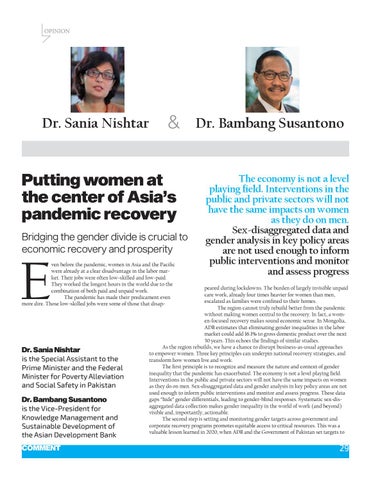OPINION
Dr. Sania Nishtar
&
Putting women at the center of Asia’s pandemic recovery Bridging the gender divide is crucial to economic recovery and prosperity
E
ven before the pandemic, women in Asia and the Pacific were already at a clear disadvantage in the labor market. Their jobs were often low-skilled and low-paid. They worked the longest hours in the world due to the combination of both paid and unpaid work. The pandemic has made their predicament even more dire. Those low-skilled jobs were some of those that disap-
Dr. Sania Nishtar is the Special Assistant to the Prime Minister and the Federal Minister for Poverty Alleviation and Social Safety in Pakistan Dr. Bambang Susantono is the Vice-President for Knowledge Management and Sustainable Development of the Asian Development Bank COMMENT
Dr. Bambang Susantono
The economy is not a level playing field. Interventions in the public and private sectors will not have the same impacts on women as they do on men. Sex-disaggregated data and gender analysis in key policy areas are not used enough to inform public interventions and monitor and assess progress
peared during lockdowns. The burden of largely invisible unpaid care work, already four times heavier for women than men, escalated as families were confined to their homes. The region cannot truly rebuild better from the pandemic without making women central to the recovery. In fact, a women-focused recovery makes sound economic sense. In Mongolia, ADB estimates that eliminating gender inequalities in the labor market could add 16.1% to gross domestic product over the next 30 years. This echoes the findings of similar studies. As the region rebuilds, we have a chance to disrupt business-as-usual approaches to empower women. Three key principles can underpin national recovery strategies, and transform how women live and work. The first principle is to recognize and measure the nature and context of gender inequality that the pandemic has exacerbated. The economy is not a level playing field. Interventions in the public and private sectors will not have the same impacts on women as they do on men. Sex-disaggregated data and gender analysis in key policy areas are not used enough to inform public interventions and monitor and assess progress. These data gaps “hide” gender differentials, leading to gender-blind responses. Systematic sex-disaggregated data collection makes gender inequality in the world of work (and beyond) visible and, importantly, actionable. The second step is setting and monitoring gender targets across government and corporate recovery programs promotes equitable access to critical resources. This was a valuable lesson learned in 2020, when ADB and the Government of Pakistan set targets to
29





